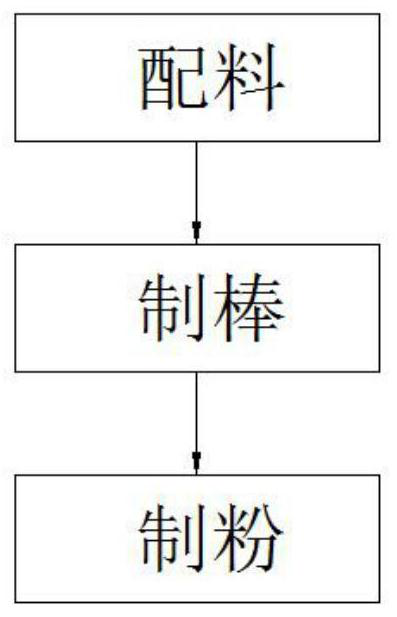3d printed ternary boride mo 2 nib 2 Alloy powder and its production process
A ternary boride and alloy powder technology, which is applied in the field of 3D printing materials, can solve problems such as alloy pollution, viscous smelting liquid, and low powder yield, and achieve broad application prospects, small friction coefficient, and improved wear resistance. Effect
- Summary
- Abstract
- Description
- Claims
- Application Information
AI Technical Summary
Problems solved by technology
Method used
Image
Examples
Embodiment 1
[0032] Example 1: A 3D printing ternary boride Mo provided in this example 2 NiB 2 Alloy powder and its production process, see figure 1 , the process steps are as follows:
[0033] (1) Ingredients: wet ball milling has more obvious advantages in terms of particle size distribution, anti-oxidation of powder, segregation and agglomeration of powder for preparing powder, so wet ball milling process is preferably used in this embodiment. Prepare the materials and their mass percentages as follows: B 3.3%, Mo 50%, Cr 10%, C 2%, V 0.5%, Nb 2%, W 0.5%, Ce 2%, Mn 4%, Ta0.3%, Ti 0.6%, binder 3%, Ni23%;
[0034] (2) Rod making: mix raw materials B, Mo, Cr, C, V, Nb, W, Ce, Mn, Ta, Ti, Ni and binder according to the formula. The binder is preferably paraffin. In other embodiments, the binder can be selected from PEG, rubber or resin, etc.; mixed with any one or more solvents such as absolute ethanol or methanol, acetone, n-heptane, n-hexane, etc. The azeotropic solvent is used as t...
Embodiment 2
[0041] Embodiment 2: A kind of 3D printing ternary boride Mo provided by this embodiment 2 NiB 2 Alloy powder and its production process, which are basically the same as Example 1, the difference is that each element and its mass percentage are as follows: B 7%, Mo 25%, Cr15%, C 1%, V 5%, Nb 3%, W 4%, Ce 0.5%, Mn 1%, Ta 1%, Ti 2%, binder 6%, Ni 29.5%.
Embodiment 3
[0042] Embodiment 3: A kind of 3D printing ternary boride Mo provided by this embodiment 2 NiB 2 Alloy powder and its production process are basically the same as in Example 1, except that the elements and their mass percentages are as follows: B 5%, Mo 30%, Cr 4%, C 0.5%, V 3%, Nb 1.5%, W 6%, Ce 0.6%, Mn 3%, Ta 0.7%, Ti 0.7%, binder 4%, Ni 41%.
PUM
 Login to View More
Login to View More Abstract
Description
Claims
Application Information
 Login to View More
Login to View More - R&D
- Intellectual Property
- Life Sciences
- Materials
- Tech Scout
- Unparalleled Data Quality
- Higher Quality Content
- 60% Fewer Hallucinations
Browse by: Latest US Patents, China's latest patents, Technical Efficacy Thesaurus, Application Domain, Technology Topic, Popular Technical Reports.
© 2025 PatSnap. All rights reserved.Legal|Privacy policy|Modern Slavery Act Transparency Statement|Sitemap|About US| Contact US: help@patsnap.com



